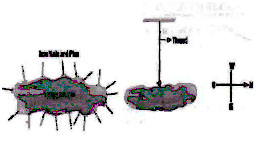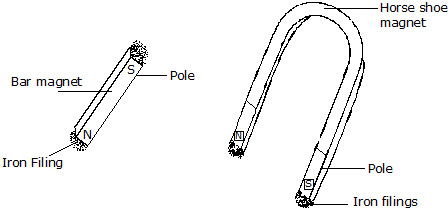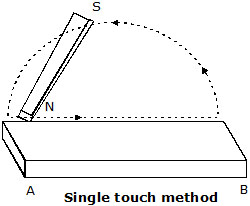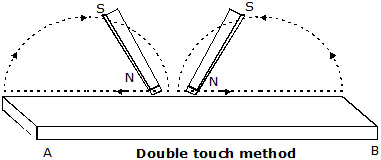Then, the end A of the iron piece becomes the north pole and end B becomes the south pole.
1. The chemical formula of magnetite (natural magnet)
2. The poles of the magnet always exist in:
3. The magnet can be demagnetised by -
4. Which of the following statements is true?
5. If there are 3 bar magnets, the total number of poles will be :
6. Which scientist discovered that current carrying wire behave as magnet?
7. Coloured part of the needle of magnetic compass represents
8. ALNICO is an example of _________ magnet (A) permanent
9. Electromagnet is an example of __________ magnet
10. A freely suspended magnet always align itself along the (A) north - south direction.
11. Which one of these is temporary magnet?
12. Which of the following is/are non magnetic materials :
1. Discuss the any one method for making a magnet.
2. Distinguish between the temporary and permanent magnet.
3. What are the methods of demagnetising a permanent magnet?
4. What is electromagnet?
5. Discuss the properties of bar magnet.
1. B 2. A 3. D 4. B 5. B 6. B
7. A 8. A 9. B 10. A 11. B 12. D
1. A freely suspended magnet takes its
direction :
(a) north-south (b) north-east
(c) east-west (d) south-east
2. Magnetic poles always exist as :
(a) dipole (b) monopole
(c) no-pole (d) none of these
3. A magnetic field can be produced by :
(a) a moving charge
(b) a changing electric field
(c) None of these
(d) Both of these
4. The phenomenon of electromagnetic induction was discovered by :
(a) Faraday (b) Lenz
(c) Maxwell (d) Fleming
5. The magnetic strength is maximum :
(a) At poles of the magnet
(b) In middle of the magnet
(c) uniform at all places
(d) none of these
6. The magnetic lines of forces :
(a) intersect each other
(b) do not intersect each other
(c) parallel to each other
(d) perpendicular to each other
7. Which one of these is temporary magnet ?
(a) bar magnet
(b) electromagnet
(c) magnetic needle
(d) horse-shoe magnet
8. A current carrying wire in the neighbourhood produces :
(a) No field
(b) electric field only
(c) magnetic field only
(d) electric and magnetic field
9. A generator or dynamo works on the
principle :
(a) magnetic affect of electric current
(b) electromagnetic induction
(c) chemical effect of electric current
(d) heating affect of electric current
10. The magnetic field lines due to a bar magnet are correctly shown in :
(a)

(b)

(c)

(d)

11. The materials suitable for making electromagnets should have :
(a) low retentivity and high coercivity
(b) low retentivity and low coercivity
(c) high retentivity and low coercivity
(d) high retentivity and high coercivity
12. Magnetic effect of current was discovered
by :
(a) Faraday (b) Oersted
(c) Ampere (d) Bohr
13. The attraction of iron filling in a magnet is maximum at :
(a) poles of the magnet
(b) middle part of the magnet
(c) all places in the magnet
(d) none of these
14. The direction of magnetic lines of forces close to a straight conductor carrying current will be:
(a) Along the length of the conductor
(b) Radially outward
(c) Circular in a plane perpendicular to the conductor
(d) Helical
15. The magnetic substance among the following is :
(a) copper (b) silver
(c) iron (d) aluminium
16. A magnet attracts from the following :
(a) Iron pieces (b) aluminium pieces
(c) copper pieces (d) glass pieces
17. Choose the correct option (s)
The magnetic field inside a long straight solenoid-carrying current
(a) is zero
(b) decreases as we move towards its end
(c) increases as we move towards its end
(d) is the same at all points
18. Magnetic poles :
(a) exist separately
(b) do not exist separately
(c) mayor may not exist separately
(d) none of these
19. Like poles of two magnet
(a) attract each other
(b) repel each other
(c) no effect for each other
(d) none of these
20. Which of the following correctly describes the magnetic field near a long straight wire :
(a) the field consists of straight lines perpendicular to the wire.
(b) The field consists of straight lines parallel to the wire.
(c) The field consists of radial lines originating from the wire.
(d) The field consists of concentric circles centred on the wire.
21. The phenomenon of electromagnetic induction is :
(a) the process of charging a body
(b) The process of generating magnetic field due to a current passing through a coil.
(c) producing induced current in a coil due to relative motion between a magnet and the coil.
(d) the process of rotating a coil of an electric motor.
22. The device used for producing electric current is called as :
(a) generator (b) galvanometer
(c) ammeter (d) motor
23. The essential difference between an AC
generator and a DC generator is that :
(a) AC generator has an electromagnet while a DC generator has permanent magnet
(b) DC generator will generate a higher voltage
(c) AC generator will generate a higher voltage
(d) AC generator has slip rings while the DC generator has a commutator.
24. In an electric motor, conversion takes place of :
(a) chemical enrgy into electrical energy
(b) electrical energy into mechanical energy
(c) Electrical energy into light
(d) Electric energy into chemical energy
25. Which one of the following substances is the magnetic substances :
(a) Mercury (b) Iron
(c) Gold (d) Silver
26. Magnetic lines do not intersect one-another because :
(a) they are at a distance
(b) they are in the same direction
(c) they are parallel to another
(d) at the point intersection there will be two direction of the magnetic force which is impossible
27. Instrument can be shielded from outside magnetic effects by surrounding them with :
(a) Rubber shield (b) Glass shield
(c) Iron shield (d) Brass shield
28. The vertical plane which passes through the magnetic axis ofa freely suspended magnetic at rest is called :
(a) magnetic meridian
(b) Geographical meridian
(c) North meridian
(d) South meridian
29. By removing the inducing magnet, the induced magnetism is :
(a) Finished after some time
(b) Finished just after
(c) Not finished for a long time
(d) Not charged
30. The similar magnets of steel are ______than the magnets of soft iron :
(a) stronger
(b) of equal strength
(c) weaker
(d) None of the above
31. The magnetism is a magnet is mainly due to :
(a) The orbital motion of the electrons
(b) the spinm motion of the electrons
(c) the nuclear charge
(d) None of the above
32. When the north pole ofa strong magnet is brought near to the north pole of a weak magnet then they will :
(a) Attract each other
(b) repel each other
(c) first attract and the repel
(d) first repel and then attract
33. A magnet can be demagnetised by :
(a) Hammering the magnet
(b) Putting it in the water
(c) Cooling it
(d) Putting in contact with iron
34. The effective length of the magnet is :
(a) The complete length of the magnet
(b) the distance between the two poles of the magnet
(c) the half of the length of the magnet
(d) the square of the length of the magnet
35. When the bars of bismuth are placed between the magnetic poles they set their length :
(a) perpendicular to the lines of force
(b) along the lines of force
(c) neither perpendicular nor along the lines of force
(d) In any direction
36. Two bars of soft iron exactly alike are given. One of them is a magnet. Without using any thing more, how would you find which is a magnet.
(a) By bringing two bars near and noting which one is attracting. The attracting one is a magnet.
(b) by bringing two bars near and noting which one is repelling. One which repells is an ordinary iron.
(c) By rubbing one bar with the other and noting which becomes magnet. The bar which is magnetised is an ordinary iron.
(d) One bar is placed flat horizontal on the table and the other bar is held vertical with its one end on the middle of first bar. If there is attraction between the two, the vertical bar is magnet otherwise ordinary iron.
37. Magnetic storms are due to :
(a) the rotation of the earth
(b) the revolution of the earth
(c) the rainy season
(d) the appearance of the spots
38. Magnetic field lines start :
(a) on N-poles
(b) on S-poles
(c) on current carrying wires
(d) Nowhere
39. Magnetic field lines form circles in the space :
(a) near a permanent magnet
(b) around a current-carrying wire
(c) inside a solenoid
(d) inside a current-carrying loop
40. A transformer used to reduce the alternating voltage is :
(a) step-up transformer
(b) step-down transformer
(c) both step-up and step-down transformers
(d) none of these
41. A tesla is equivalent to a :
(a) newton per coulomb
(b) newto per ampere-meter
(c) ampere per newton
(d) newton per ampere-second
42. A vertical wire carries a current upwards. The magnetic field north of the wire will be
directed :
(a) upward (b) eastward
(c) westward (d) northward
43. The current in the armature of a motor is reversed every half cycle due to the action of
(a) armature (b) field coil
(c) brush (d) commutator
44. For dynamo which one of the following statements is correct :
(a) it converts the electrical energy into light energy
(b) it converts the kinetic energy into heat energy
(c) it converts the mechanical energy into electrical energy
(d) it converts the electrical energy into mechanical energy
45. If a bar magnet is cut length wise into 3 parts, the total number of poles will be :
(a) 2 (b) 6
(c) 3 (d) 4
46. A soft iron bar is introduced inside a current carrying solenoid. The magnetic field inside the solenoid :
(a) will becomes zero
(b) will decrease
(c) will increase
(d) will remain unaffected
47. The magnetic lines of force, inside a current carrying solenoid are :
(a) along the axis and are parallel to each other
(b) perpendicular to the axis and equidistant from each other
(c) circular and they do not intersect each other
(d) circular at the ends but they are parallel to the axis inside the solenoid.
48. For making a strong electromagnet, the material of the core should be :
(a) soft iron
(b) steel
(c) brass
(d) laminated steel strips
49. Wrist watches are made antimagnetic by shielding their machinery with :
(a) plastic sheets
(b) a metal of high conductivity
(c) a magnetic substance of low permeability
(d) a magnetic substance of high permeability
50. When a bar magnet is broken into two
pieces :
(a) we will have a single pole on each piece
(b) each piece will have two like poles
(c) each piece will have two unlike poles
(d) each piece will lose magnetism
ANSWER KEY
1. A 2. A 3. D 4. A 5. A 6. B 7. B 8. C 9. B 10. D 11. C 12. B 13. A 14. C 15. C 16. A 17. D 18. B 19. B 20. D
21.C 22.A 23.D 24.B 25.B 26.D 27.C 28.A 29.B 30.C 31.B 32.A 33.A 34.B 35.A 36.D 37. D 38. D
39.B 40.B 41.B 42.C 43.D 44.C 45.B 46.C 47.A 48.A 49.D 50. D







